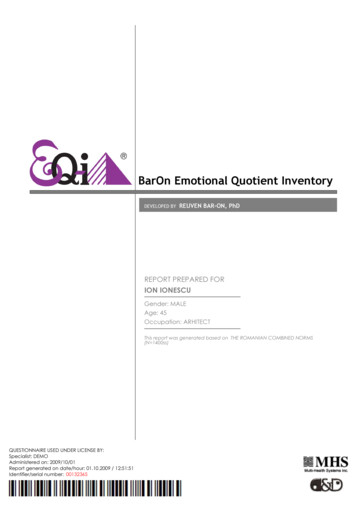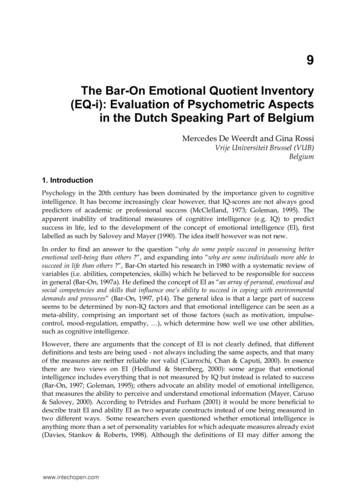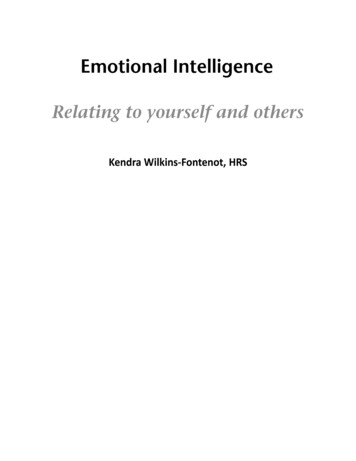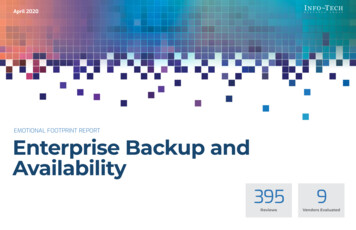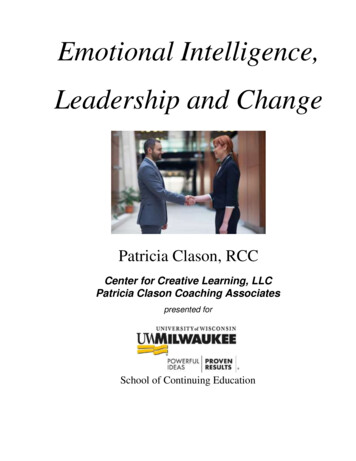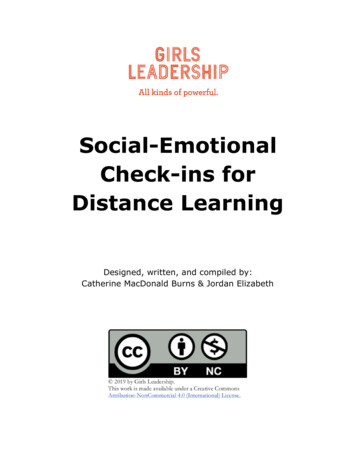
Transcription
Social-EmotionalCheck-ins forDistance LearningDesigned, written, and compiled by:Catherine MacDonald Burns & Jordan Elizabeth
Authors’ NoteWhy social-emotional learning?“This unprecedented shift to a new type of learning experience may have alasting and profound impact on young people’s academic, social, emotional,and life outcomes.” -CASEL, the Collaborative for Academic, Social, andEmotional LearningWe know that in order for our young people to process this experience, feelsupported by their learning environment, and build skills to cope, heal, andthrive, it will mean the focus must begin with connection and reflection onour shared community. We create the environment and opportunities inwhich growth is possible, and social-emotional learning provides the tools.How can I use this resource?This resource is highly adaptable and is intended as a foundation to groundstudents in a brave space. These activities can be used as check-ins at thebeginning of class, check-outs at the end, breaks or transitions betweenother work, or standalone lessons. Create your own sequence, choose a fewrepeatable structures that you find are particularly impactful, or use these asa jumping-off point to create your own social-emotional check-ins. You knowyour students best. Listen for what’s working for them and what’s not.What can I do to create a brave space for my students?Start by assessing your students’ perception of the space. Below, you’ll findthe Healing Centered Environments checklist. Take inventory of thisyourself, and then turn the questions to your students. Giving studentspower to co-create the space in which they’re learning encourages agencyand leadership, and will increase investment and engagement.Brave spaces are about trust, acceptance, and accountability. Facilitators willfind strategies that work best for their style and needs of their classstructure, but there are some best practices all facilitators can use. Modelingvulnerability, amplifying students’ voices, and having clear and consistentexpectations and routines will go far to building this sense of community inwhich learners both rely upon and push each other.1Join us for professional development: girlsleadership.org/PD
Healing Centered Environment for Distance LearningOnline Space Teachers and students have space to connect in real-time and communicate with eachother Student work is shared with the class and celebrated Teacher gives options for sitting, standing, and movement during live sessions Teacher allows for water breaks and bathroom breaksInstruction/Relationships Students and teachers know each other’s names and pronounce them correctlyStudents given opportunity for voice and choiceStudents and teachers are encouraged to share stories as a way to connect and learnConversations and communication happen more often than getting in troubleStructures/Routines There are class agreements that students helped create Agendas and agreements are shared for everyone to see There is time built in for mindfulness and reflection2Join us for professional development: girlsleadership.org/PD
Table of ContentsTo Energize Countdown Shakedown . .p. 4One-Song Pump-Up . .p. 6Affirmation Circle . .p. 7Pictogram .p. 9Knowledge Is Power Hour .p. 12To Center Box Breathing .p. 14Guided Meditation . .p. 16Anxiety Grounding . .p. 18Zen Counting .p. 19One Word Story .p. 21To Connect Name Decoration . .p. 22Sun Shines On . .p. 23Roses & Thorns . .p. 25Mirror & Window .p. 27If You Really Knew Me . .p. 29To Reflect Healing Centered Checklist for Home . .p. 31Comfort Zones Part 1 .p. 33Comfort Zones Part 2 . p. 35Future Focused Prompts .p. 37Stressors .p. 38Individualism/Collectivism . .p. 41To Advocate Good Vibes .p. 43Student Soapbox .p. 45If I Ran The World .p. 47#Goals .p. 48Cultural Appreciation .p. 513Join us for professional development: girlsleadership.org/PD
Countdown Shakedown Check-inLevel: AllDomain: Mindfulness Self-CompassionObjective/Rationale: To givestudents a chance to re-energize,shake off tension, and get their bodiesmoving. Great as a warm-up, a break,an energizer, or a transition from atough subject.Time Required: About 3-5minutes.Materials: Ability to hear eachother.Disclaimers/Notes: SeeDifferentiation opportunities atbottom.Prompt: Frame this around what you feel is happening in the space, whatyou notice about the energy, or how this game sets you up for the workyou’re moving into or out of.Have students stand up with enough space to spread their arms and legswide. Ask them to count along with you.Counting aloud, you’ll shake each limb starting with 8 times, and reducingthe number of shakes by 1 each round.Start with your right arm. Count your shakes aloud: 1, 2, 3, 4, 5, 6, 7, 8.Immediately switch to your left arm for 8 counts. Then right leg. Then leftleg.When you get back to your right arm, count aloud: 1, 2, 3, 4, 5, 6, 7.Left arm 7 counts. Right leg 7 counts. Left leg 7 counts.Back to right arm. Count aloud to 6, etc.Keep going until you get down to 1 count per limb.4Join us for professional development: girlsleadership.org/PD
This will start slow and get faster.Once students are familiar with this game:Call and ResponseFacilitator: Countdown Shakedown!Students (clap on count): 1, 2, 3, 4, 5, 6, 7, 8!Facilitator: Let’s goDiscussion/Follow-up:“Compare how you felt before and now how you feel after CountdownShakedown. What do you notice in your body?”Differentiation: Process: For mobility, you can have students do this seated, using onlyarms or hands, or adjust as necessary. Content: You can count down and then back up for a longer exercise.5Join us for professional development: girlsleadership.org/PD
One-Song Pump-UpLevel: AllDomain: Brave Space GroundworkObjective/Rationale: To energize,get bodies moving, and laughtogether. This works great as awarm-up, transition, or energizer.Time Required: 3-5 minutes - onesong!Materials: Music - facilitator canplay music with volume and soundon so students can hear via videochat.Disclaimers/Notes: Adjust formobility needs.Prompt: Have students get out of their seats and make room to move forthe duration of one song.There are a few different ways to do this: Facilitator leads and switches up moves: can be dancing or work-outmoves or just silly gestures. Facilitator begins and “popcorns” to different students to lead the nextmove for 10 seconds each. Students continue to popcorn. Facilitator frames: Our goal is to pump each other up as much aspossible. We are a team and today this is our anthem. Let it go fromthere.Take song suggestions from students, or, here are some initial suggestions:Level Up by CiaraShake It Off by Taylor SwiftLet’s Get It Started by the Black Eyed PeasJump Around by House of PainLet It Go from FrozenBaby Shark (try this with high schoolers)Differentiation: Process: Change it up for mobility accommodations.6Join us for professional development: girlsleadership.org/PD
Affirmation CircleLevel: AllDomain: Mindfulness Self-CompassionObjective/Rationale: To givestudents a space where they can statewhat they need to hear and havesupport from peers. Positiveintention-setting for the day andcommunity-building.Time Required: Depends ongroup size. 3-minute intro, andabout 10 seconds per person.Materials: Ability to see eachother is helpful.Disclaimers/Notes: Encouragestudents to think of an empoweringphrase that is appropriate andmeaningful. For inappropriateresponses, simply say “Try again!” Ifthey do not come up with somethingappropriate on the next chance, say“Moving on!” and go to the nextstudent.Prompt:Optional: Share video using “share screen” function. Make sure your soundand volume is on, and students are muted.https://www.youtube.com/watch?v ShB118J6LlsAsk: “What is an affirmation?”Source answers from the group.Say: “An affirmation is a phrase that empowers us, reminds us of who weare, and helps us with positive self-talk. Sometimes we get down onourselves and find that our self-talk becomes critical or negative, and it canmake us feel down. Today we’re going to use affirmations together toempower each other. I’m going to ask each of you to come up with anappropriate affirmation for yourself: what do you need to hear today?”Give students think-time to come up with their own affirmations. Model this.7Join us for professional development: girlsleadership.org/PD
Say: “In a moment we’re going to go around. Each of you will say youraffirmation in the first person: for example, I am a hard worker. Aftersomeone says their affirmation in first person, we’re all going to chime inand confirm that affirmation for them. So we would say “You are a hardworker!”Facilitator set an order (this can be done in chat or out loud). Ask studentsto un-mute themselves. Facilitator begin with their own example.Discussion/Follow-up:Once everyone has gone, give a round of snaps.Optional Follow-up Question: “What was it like to say your affirmation aloudand have it confirmed for you by the group?”8Join us for professional development: girlsleadership.org/PD
Pictogram Check-inLevel: High SchoolTime Required: 10-15 minsDomain: GamesMaterials: COVID-19 PictogramObjective/Rationale: This activityDisclaimers/Notes: Be responsiveengages the right hemisphere of thebrain, which primes students forthinking creatively, nonlinearly, andabstractly.to the level of English proficiencyamong your students. Vet this activityfor references that may beinappropriate for some settings.Prompt: Whole group or in small groups, invite participants to solve thepictogram. Share your screen to solve together, or post on a platform.Discussion/Follow-up: Share out!ANSWER KEY:1. Corona virus2. Pandemic3. Isolation4. Quarantine5. Antiseptic6. Online classes7. Empty places8. Social distancing9. Elbow bump10. Flatten the curveDifferentiation: Process: This could be a check-out activity, and discussion could takeplace during the following class.9Join us for professional development: girlsleadership.org/PD
10Join us for professional development: girlsleadership.org/PD
11Join us for professional development: girlsleadership.org/PD
Knowledge is Power HourLevel: All, works best for Middle High School.Domain: Identity Self-AwarenessObjective/Rationale: To givestudents an opportunity to explorequestions they’re curious about. Tore-engage students in the learningprocess who may be feelingdisenchanted with distance learning.Time Required: This can be aquick 10-minute check-in, oradapted to a longer ongoingproject.Materials: This can be done viavideo chat or discussion thread.Disclaimers/Notes: Ask studentsto keep their questions appropriate -rated PG.Prompt: “What is a question or topic you’re curious about and would beinterested in learning that we don’t really get to focus on in school?”Expect answers from all over the board. Feel free to share about somethingyou were interested in while you were in school that you learned aboutoutside of school.Some examples from past experiences:“Who invented chocolate?”“How do you become a sports announcer?”“Are horses street legal?”“If the universe is constantly expanding, what is it expanding into?”“What is the rarest animal on Earth?”Discussion/Follow-up: If there are questions or areas of interest thatcome up that align to a field of study or a trade, point it out! Let studentsknow if there’s a way for them to study that question in the future in theirschooling.12Join us for professional development: girlsleadership.org/PD
Differentiation: Process/Product: This can be done as a longer term project. Oncestudents have come up with their questions they’re curious about, youcan give them a week or so to research it and come back with 3-5slides that answer their question or address what they learned abouttheir topic. Let students be “professor for a day” and present theirfindings. If other students have questions or additional informationthey can provide, allow a “talk-back session” following eachpresentation. Content: A debrief question for this longer term exercise can be, “Howdid you learn new things about this topic? What skills and resourcesdid you use? What motivated you?”13Join us for professional development: girlsleadership.org/PD
Box Breathing Check-inLevel: AllTime Required: 5-10 minsDomain: Mindfulness Self-CompassionMaterials: Ability to watch anonline videoObjective/Rationale: To giveDisclaimers/Notes: Focusing onstudents strategies to self-regulate.our bodies can be uncomfortable andeven scary; particularly for individualswhose bodies store memories oftraumatic events. This is an opt in/optout exercise, meant to exposestudents to different mindfulnesspractices that work best for them.Recognizing what works/does notwork for them is a mindfulnesspractice in itself and ought to becelebrated.Prompt:Say: Mindfulness is the practice of being fully aware of each present momentand getting in touch with how we feel physically and emotionally.Studies show that mindfulness reduces stress hormones by calming thesympathetic nervous system, which is responsible for our responses todanger.One way to practice mindfulness is through focused breathing.Feel free to turn off your cameras and microphones while we follow alongwith this video: https://www.youtube.com/watch?v AOL3isokmY4Discussion/Follow-up:14Join us for professional development: girlsleadership.org/PD
Discussion Questions:1. How do you feel physically after box breathing?2. How do you feel emotionally after box breathing?3. What are some real-world benefits to practicing mindfulness?Differentiation: Process: Using the thumb-scale method, invite students to rate theirexperience -- thumb DOWN for bad, thumb to the SIDE for neutral,and thumb UP for good. Based on their response, arrange studentsinto small groups to answer the debrief questions.15Join us for professional development: girlsleadership.org/PD
Guided Meditation Video Check-inLevel: AllDomain: Mindfulness Self-CompassionObjective/Rationale: To givestudents an opportunity to step backand practice mindfulness before orafter learning. This can be done as acheck-in or a check-out protocol.Especially useful if student energy isall over the place and they need achance to re-regulate.Time Required: Anywhere from10-20 minutes.Materials: Ability to hear video.Disclaimers/Notes: Best practiceis to have students mute their micsand turn video off while the meditationis happening. The videos do notrequire screen sharing, only sound isneeded to engage.Prompt: Choose one of the videos from the Girls Leadership Mindfulnessplaylist on YouTube:https://www.youtube.com/playlist?list PLI615uhXqtJE4ux4D6WppZxg0T9L9TvVlIf mindfulness and meditation is new for your students, choose a shortervideo first.Ask: “How many of you have done a guided meditation or have amindfulness strategy that you use? What’s the purpose of mindfulness?”If you have a mindfulness practice that you use, share it out. Invite otherstudents to share.Say: “When we’re facing times of stress or uncertainty, or things feel out ofour control, it can be hard to get present to the current moment and checkin with ourselves. But it’s one of the best things we can do to feel moreconnected to ourselves and give our brains time to settle and refocus. Let’stry it out and see how it goes.”16Join us for professional development: girlsleadership.org/PD
Prompt students to turn off mics/videos, and find a comfortable position.Play video -- make sure your volume and sound are up (and ask students tomake sure their sound is on even if they’re muted!)Discussion/Follow-up:“What did you notice? How does your body feel after the guided meditation?What did you like? What was weird?”Differentiation: Process: Give students access to the playlist and allow them tochoose which meditation they’d like to engage with at the beginning ofclass. Give a time limit if necessary.17Join us for professional development: girlsleadership.org/PD
Anxiety Grounding Check-inLevel: AllTime Required: 5-10 minsDomain: Mindfulness Self-CompassionMaterials: NoneObjective/Rationale: Payingattention to our bodies helps clear themind and connect us to the presentmoment.Disclaimers/Notes: Bringingattention to our bodies can bepotentially triggering; students mayresist by giggling, tuning out, etc.That is okay -- gently bring them backto the exercise.Prompt:Invite students to write down:5 things they can see (allow some time for them to write between each prompt)4 things they can feel 3 things they can hear 2 things they can smell 1 thing they can taste.Discussion/Follow-up:Discussion Questions What did you notice in this exercise? Were some prompts more challenging than others? Why do you think it’s called a “grounding” exercise?Differentiation: Environment: Instead of individual reflection, this activity can bedone in pairs.18Join us for professional development: girlsleadership.org/PD
Zen Counting Check-inLevel: AllDomain: GamesObjective/Rationale: To givestudents a chance to connect with theenergy of the people in the space. Thisis a great activity to promoteconnection and focus.Time Required: About 5-10minutes.Materials: Ability to hear eachother.Disclaimers/Notes: Sometimesstudents will get the giggles duringthis. If that happens, ask students totake a deep breath all together andstart again.Prompt:Have students turn their microphones on.“Our goal is going to be to count as high as we can as a group. We can’t goin a pattern, and each person can’t say the same number each round. Ifmultiple people say the same number at the same time, it’s not the end ofthe world, we just start back at 1. Let’s see how high we can count.”If two students say a number at the same time:“Back to 1.”If students are giggling or talking:“Let’s re-set. Laugh as hard as you can right now. OK. Together, let’s takethree deep breaths, and then let’s start back at one. How high can wecount?”Discussion/Follow-up:“What do you notice about the rounds where we were most successful?”19Join us for professional development: girlsleadership.org/PD
Differentiation: Process: You can have students do this with cameras off so they can’tsee each other and then switch to cameras on. Ask which helped thembe more successful and why they think that is. Product: This can be a one-time game or you can ritualize it. Keeptrack of the highest number you’ve gotten to as a class and try to beatit next time.20Join us for professional development: girlsleadership.org/PD
One Word Story Check-inLevel: AllTime Required: 10-15 minsDomain: GamesMaterials: Ability to hear eachother.Objective/Rationale: This activityencourages deep listening, creativity,and group-mind. It also challenges theidea that individual effort/recognitiontrumps group success.Disclaimers/Notes: The story maygo off the rails, that’s okay. Initiatethe end of the story and start again.Students get to explore their comfortlevel with individualism vs.collectivism and define how they wantto work together.Prompt: Say: “We're going to tell a story, but each of us can only add oneword at a time as we go from person to person, creating sentences. Try notto get too attached to the perfect word; just say a word that keeps thesentence going. If you need a name, use the ones already mentioned. Samewith objects, actions, or emotions. The more you can reincorporate ideas inthe story, the tighter it will become. To initiate the final sentence, I will say,“And in the end ” or “The moral of the story is ” Now, who has a title forthis story?"Establish an order for participants.Discussion/Follow-up:Discussion Questions: What did you notice in yourself? What did you notice in the group? What was challenging/easy? What could we do next time to improve our storytelling?Differentiation: Environment: If the whole group is too large, invite smaller groups totry the activity while others watch. Then rotate.21Join us for professional development: girlsleadership.org/PD
Name DecorationLevel: AllTime Required: 15-20 minsDomain: Brave SpaceMaterials: Paper and utensils orvirtual space for collage (sharedGoogle Slides document or similar)Objective/Rationale: To givestudents a way to connect aroundidentity and center the voices andexperiences of students.Disclaimers/Notes: Let studentsknow it’s important and valuable tocorrect people who pronounce theirname incorrectly. The group shouldmake an effort to learn each other’snames and how to pronounce themcorrectly as early as possible. Thisaffirms identities.Prompt: Have students write or draw on paper, or create virtually, arepresentation of their name. Around their name, they should decorate withdrawings, symbols, or words that they feel represent parts of their identity.Give every student space to share the name they want to be addressed by inthis space, and anything else they feel is important about their identity toshare with the group. This could be more about their name, but could alsobe about other aspects of their identity they feel are important and want tobe respected in this space.Facilitator can model this first.Discussion/Follow-up:“What was it like to share your name?”“Did anyone learn anything new about someone through this activity?”Differentiation: Process: If you have a large group, it can be useful to give a quickformat for sharing. Your name, what it means to you, and one aspectof your identity.22Join us for professional development: girlsleadership.org/PD
Sun Shines OnLevel: AllDomain: Identity Self-AwarenessObjective/Rationale: Sharing andconnection. Giving students anopportunity to get to know each otheron a deeper level even when they’renot together.Time Required: Depends ongroup size, but about 10-15minutes.Materials: Ability to see eachother.Disclaimers/Notes: Remindstudents that what they share shouldbe true for them. Also make surethey’re not calling each other out onthings they think are or are not truefor their peers. Keep students on muteunless they are the one speaking.Prompt: “This game is called “The Sun Shines On.” We’re going to get toknow each other a little bit better in three rounds. In each round, eachperson will share something that is true for themselves. Everyone else willuse a gesture to show if that is also totally true for them, kind of true forthem, or not true for them. If a statement is totally true for you, you’ll putboth hands in the air and wiggle your fingers. If a statement is a little truefor you, you’ll raise one hand. If a statement is not true for you, you’ll sitstill. Keep in mind we’re not yucking anyone’s yum. If it’s not true for you,even if you totally disagree, you can stay neutral.”Prompt Round #1: I like/I am good at.Examples: I like riding my bike. I am good at drawing.Prompt Round #2: I have (experienced).Examples: I have broken a bone. I have gone swimming in the ocean.Prompt Round #3: I am.Examples: I am the oldest child. I am someone who struggles withdepression.To give an example of how the gestures work:23Join us for professional development: girlsleadership.org/PD
Let’s say someone says “I am a sister.” If I have siblings, I would do silentapplause. If I maybe don’t have biological siblings but I consider my cousinlike my sibling, I might put one hand in the air. If I don’t consider myself asister, I would keep my hands down and sit still.Discussion/Follow-up:“Did anyone notice something they had in common with someone else thatsurprised them?”Differentiation: Process: If students are not comfortable with their faces on screen,have them use the “reactions” (clapping hands for “totally me” and thumbsup for “kind of me,” no reaction if it doesn’t apply.) Or have them add theiranswers in the chat.24Join us for professional development: girlsleadership.org/PD
Roses & ThornsLevel: AllDomain: Brave SpaceObjective/Rationale: To givestudents space to connect and sharewhat’s going well and what’s hard forthem in a choose-your-own-riskformat.Time Required: Depends ongroup size. About 10-30 secondsper person.Materials: Ability to see eachother is helpful, not required.Disclaimers/Notes: Somestudents may “pass” or opt out. Givethem another opportunity onceeveryone else has shared. Somestudents may say they have a “thorn”but no roses, or vice versa. If anystudent’s answer stands out to you asparticularly concerning, check in withthem individually at a later time. Don’tmake this request in front of otherstudents.Prompt: “If life were a flower, it would be a rose: a combination of beautifulexperiences and prickly thorns to navigate. When thinking about life over thepast week or so, what is your rose? What’s a nice, lovely, positiveexperience you’ve had, something that’s made you happy? What’s a thornyou’ve been navigating, something that has been challenging or difficult foryou? We’re going to go around and each get an opportunity to share onerose and one thorn. This is choose-your-own-risk; you don’t have to shareanything you’re not comfortable sharing.”Facilitator share personal example to model the exercise.25Join us for professional development: girlsleadership.org/PD
Example: My rose this week was getting to read to my little sister beforebed, and my thorn is that my mom and I have been arguing a lot.Discussion/Follow-up: In a group where there is already trust built, it’spossible to invite cross-talk once everyone has shared. Cross-talk can soundlike support or solidarity, or a respectful question.Students can opt into or out of cross-talk. A way to ask students to showthey’re open to cross talk is to have them hold their right ear (if everyonecan see each other) or use the chat function to just type “Open” if they’recomfortable sharing more or hearing from others.Example of cross-talk: “I read to my little brother before bed, too. Whatbook did you read to your sister?” Or “I’ve been having arguments with mymom, too. It’s really hard, I get it.”Differentiation: Process: Students can type in the chat instead of sharing out loud.26Join us for professional development: girlsleadership.org/PD
Mirror & Window Check-inLevel: AllTime Required: 10-15 minutesDomain: Diversity SocialAwarenessMaterials: Ability to hear and seeeach other.Optional: blank paper and writingutensilObjective/Rationale: To allowstudents to reflect on what they see inthemselves and others. Great forperspective-taking and reflection.Disclaimers/Notes: Prompts areadaptable! If you’re trying to getstudents to explore differentperspectives, try it in this format.Prompt: “What does this look like in a mirror? What does it look likethrough a window?”Explain: Our perceptions and experiences feel unique to us, but often othersare dealing with or processing the same things, maybe just in differentways. In this exercise, we’ll get a chance to examine how we’re impacted byour experiences and how others may be impacted by theirs.Possible Prompts: How does stress show up for you in your feelings, thoughts, andbehaviors? How can it show up for others? How do stereotypes impact you? How do you see stereotypesimpacting others? How has distance learning had an impact on you? How do you feeldistance learning has had an impact on your teachers or parents? What is the kindest thing someone’s done for you? What’s the kindestthing you’ve done for someone else?27Join us for professional development: girlsleadership.org/PD
Discussion/Follow-up:“When might it be helpful to look in the mirror for perspective? When mightit be helpful to look through a window?”Differentiation: Product: You can have students reflect on the prompt and draw amirror and a window side-by-side with their thoughts, then share it outwith the group.28Join us for professional development: girlsleadership.org/PD
If You Really Knew Me Check-inLevel: Middle and High SchoolTime Required: 15-20 minutesDomain: Identity Self-AwarenessMaterials: Ability to hear and seeeach other.Objective/Rationale: To giveDisclaimers/Notes: This is anstudents insight into understandingeach other better and allow openspace to share identities.activity best done in a group that hasalready established a trustingenvironment. Prep students ahead oftime to hold space for each other andbe willing to be surprised by what theylearn.Prompt: “We can each probably come up with some things that we reallywish everyone knew or understood about us. It might be the way wepronounce our name, something that we love to do, a part of ourselveswe’re still getting comfortable with, or something that we hope others willgive us support around. In order for others to understand us, it requires usto take the risk of sharing. So today, you’re going to choose somethingyou’re comfortable sharing with the group that you think is important toknow about you. Our prompt is “if you really knew me, you would know ”Students can also begin this prompt with “Some people might think I’m.butif you really knew me, you would know ”Give students about 30 seconds of think time. Have everyone mute theirmicrophones except for the speaker.Facilitator should begin with an exemplar and to model setti
other work, or standalone lessons. Create your own sequence, choose a few repeatable structures that you find are particularly impactful, or use these as a jumping-off point to create your own social-emotional check-ins. You know your students




